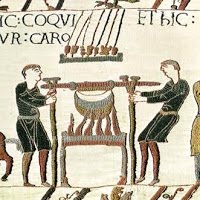 Image at left: A stitched depiction of two cooks on the 11th century Bayeux Tapestry.
Image at left: A stitched depiction of two cooks on the 11th century Bayeux Tapestry.
One of my favorite gluten free baked goods made by my wife is her Vanilla Bean Cake. Or maybe you’ve tried her garbanzo bean flatbread. Making a cake and bread with beans is an innovative way to to replicate the spongy texture of wheat. We’ve all seen those packaged gluten-free mixes that use dry garbanzo bean flour. Kelly’s bean cakes and breads (which don’t taste like beans at all) use cooked beans like white beans, navy beans, and garbanzo beans. Such a progressive idea, right? Well, it turns out the practice of making baked goods with beans goes back to at least the 11th century.
This month I was reading a history of daily life in Norman England when I came upon a passage describing how peasants would add beans to their bread flour when there was a poor harvest. This text inspired me to find a kids book about Medieval life to read Zoe and Ashley at bedtime. We borrowed The Luttrell Village, by Sheila Sancha, an illustrated book about a 14th century village in England. It too explains “…the villagers also made barley or rye-bread, and when their sacks were getting empty at the hungry time of year—before the next harvest—they but beans into the dough.” I was surprised. Until recently I have only read about the ancient food of the Celts, Greeks, and Romans, which never mentioned bean-bread. I then checked a scholarly book about Saxon food. It doesn’t offer much detail, but it says the Anglo-Saxons also added beans to their flour when ordinary bread grains were in short supply.
Kelly was fascinated to hear this. The first thing she wanted to know was whether the beans were ground into a dry flour or boiled and mashed. I knew boiling was the most common way of cooking food. Boiling consumed less fuel for the fire, than roasting. There was nearly always a cauldron of something simmering over the fire in ancient households. I also knew that Medieval villagers resented grinding their grains at the lord’s mill. In feudal villages it was actually against the law to own a personal size hand-mill for grinding grains into flour. Peasants were obligated to bring their wheat, barley, and oats to the village water-powered or wind-powered mill. The miller, always an unpopular member of the village, took a cut of the villager’s flour as a fee. My assumption was that the beans were most likely boiled and mashed. This conclusion is supported by reading Life in Medieval Village. The authors of this text say boiling was preferred because, “it required no milling and therefore escaped both the millers exaction and the natural loss of quantity in the process.”
In Medieval England wheat bread was indeed the most desirable, but it tended to be eaten mostly by the upper class. Most of the wheat grown by peasants went to market or to the lord of the village. Peasant bread was made primarily from lower-gluten barley or rye. And when those grains were in short supply beans were mixed into the dough. As time went on wheat became more abundant and less expensive, so the cost-saving measure of adding beans became unnecessary and unknown to most us.
References:
1. Hagen, Ann. Anglo-Saxon Food & Drink.
2. Gies, Frances and Joseph. Life in a Medieval Village
3. Rowley, Trevor. Norman England
4. Sancha, Sheila. The Luttrell Village


Carrie says
What a wonderful article Kelly! I am in love with the history of baking and cooking and this was an incredibly fun and educational read! I’m definitely going to try your vanilla bean cake now!! 🙂
Jes says
Thanks Andy! This is so exciting to hear. I’ve been itching to try to make Kelly’s Vanilla Bean Cake. I finally have all the ingredients now.
Maggie says
Thanks Andrew for a great piece about medieval baking! I just finished World Without End so the timing of your article was perfect! Certainly you’ve read it? I am also fascinated by social history so this was right up my alley! Thanks!
gfe--gluten free easily says
Fascinating! Everything old is new again. 😉 Lots of people are commenting for your cookbook giveaway that they want to make your Vanilla Bean Cake! I need coconut flour still. Is there another source for coconut flour other than Bob’s Red Mill, Kelly?
Thanks!
Shirley
Stephanie Eastman says
Very interesting!! Hey, I am SOOO EXCITED to hear that you have another cookbook… where did I miss out on that one?? I have used The Spunky Coconut cookbook so much that the pages are falling out and many pages have that special texture you only get from splattering batter on them and letting it dry. Can’t wait to get the second one!!
Wendy @Celiacs in the House says
Oh, a history lesson with food. We homeschooled and this topic is a favorite. We actually own several titles you mention. History Geeks are us. With my Norman English ancestry and having seen the Bayeux Tapestry in person, it’s even more exciting. Guess I need to revisit the diet of my ancestors and try beans in baking. Yuck is my experience with some of the bean flour baked goods. As luck would have it, I just cooked up a big batch of beans for a pot of soup and to freeze. Some of those babies are going into a cake.
Lexie | Lexie' says
Very informative Andy. Thanks for sharing this. I really admire how you support Kelly. You two are a great team!
Tasty Eats At Home says
Very informative read! Love this.